
1. because these new recourses were being used very frequently, there was then a greater need and demand for resources such as coal, and then began a mass produce.
2. recources
2.1. The use of biomass energy ends when many new energy sources came into knowledge and use. Recources such as coal, electricity, nuclear energy and gas were starting to be used frequently.
2.2. New recourses meant that production in place such as cotton mills was higher.
2.3. Coal mines were established in countries such as Britain far from the cities, and in China where their coal mines were close.
2.4. coal
3. economic
3.1. new economic ideas during the industrial revolution included that people could buy and sell land, labour and goods freely. These ideas were argued by people such as Adam Smith.
3.2. cotton exports came into Industrial economies and textile exports came out of industrial economies
4. Crash Course
5. social
5.1. many people in this time period seemed equality
5.2. it was very poor in cities such as london.
5.3. in the Industrial Revolution many people migrated from rural to urban areas, because of things such as lack of jobs, and so they came into cities such as london to get jobs, and because of this population numbers dramatically increased.
5.4. after people moved into these cities, they would later find out that there isn't many jobs because of the new machinery and because child labour was legal. So many children were forced to work to earn money for there families , but most of the time they wouldn't get enough money, and so many families were forced to steal, and crime dramatically increased in poorer parts of the cities.
5.5. because of all the pollution from the factories many people (mainly Kids) got sick and therefore the city had to build more hospitals .
6. politics
6.1. democracy is system of government in which power is vested in the people, who rule either directly or through freely elected representatives. This is very important to the contribution of the industrial revolution because even today it is the most used type of political system or form of government.
6.2. feudalism was failing because a number of reasons. Urbanisation, Global trade and International Banking, literacy, and egalitarian concepts of democracy promote ideas of national identity language, culture, and the idea that slavery. but the main 2 reasons are that the idea of democracy was being spread around the world by certain individuals, and that the feudal system was only made to accommodate those at the top and because most of the population was in the bottom half, many people started to rebel against the system, as we saw in the French Revolution. Fro this democracy started to spread around europe and the world.
7. machines
7.1. steam engine
7.1.1. A steam engine is a heat engine that performs mechanical work using steam as its working fluid. In 1698, Thomas Savery, an engineer and inventor, created the steam engine which was possibly the greatest invention in history, and the steam engine is still used often today.
7.1.2. The steam engine also made production faster in places such as cotton mills and coal mines to what they usually would.
7.1.3. steam engines have been used to power a wide array of transport appliances which include: the Steamboat, Steamship, Steam locomotive, Fireless locomotive, Traction engine, Steam tractor, Steam wagon, Steam bus, Steam car , Steam roller, Steam shovel, Steam tank, Steam tank. The steam engine made transportation significantly easier and quicker to used.
7.2. spinning jenny
7.2.1. The spinning jenny, is a multi-spindle spinning frame, and was one of the key developments in the industrialization of weaving during the early Industrial Revolution. It was invented in 1764 by James Hargreaves
7.2.2. the spinning jenny was commonly used for weaving in cotton mills.

